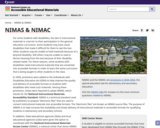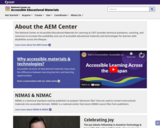
or some students with disabilities, the text in instructional materials is a barrier to their participation in the general education curriculum. Some students may have visual disabilities that make it difficult for them to see the text. Other students may be unable to hold materials because of a physical disability. Still others may be unable to read or derive meaning from the text because of their disability-related needs. For these reasons, some students with disabilities need instructional materials that are converted into accessible formats in order to learn the same curriculum that is being taught to other students in the class.
In 2004, provisions were added to the Individuals with Disabilities Education Act (IDEA) to help improve the quality and delivery of accessible formats to students with disabilities who need such materials. Among these provisions, States were required to adopt NIMAS, which stands for the National Instructional Materials Accessibility Standard. NIMAS is a technical standard used by publishers to prepare “electronic files” that are used to convert instructional materials into accessible formats. The “electronic files” are known as NIMAS source files. The purpose of NIMAS is to help increase the availability and timely delivery of instructional materials in accessible formats for qualifying students in elementary and secondary schools.
- Subject:
- Education
- Special Education
- Material Type:
- Primary Source
- Author:
- National Center on Accessible Educatonal Materials
- Date Added:
- 08/15/2022
